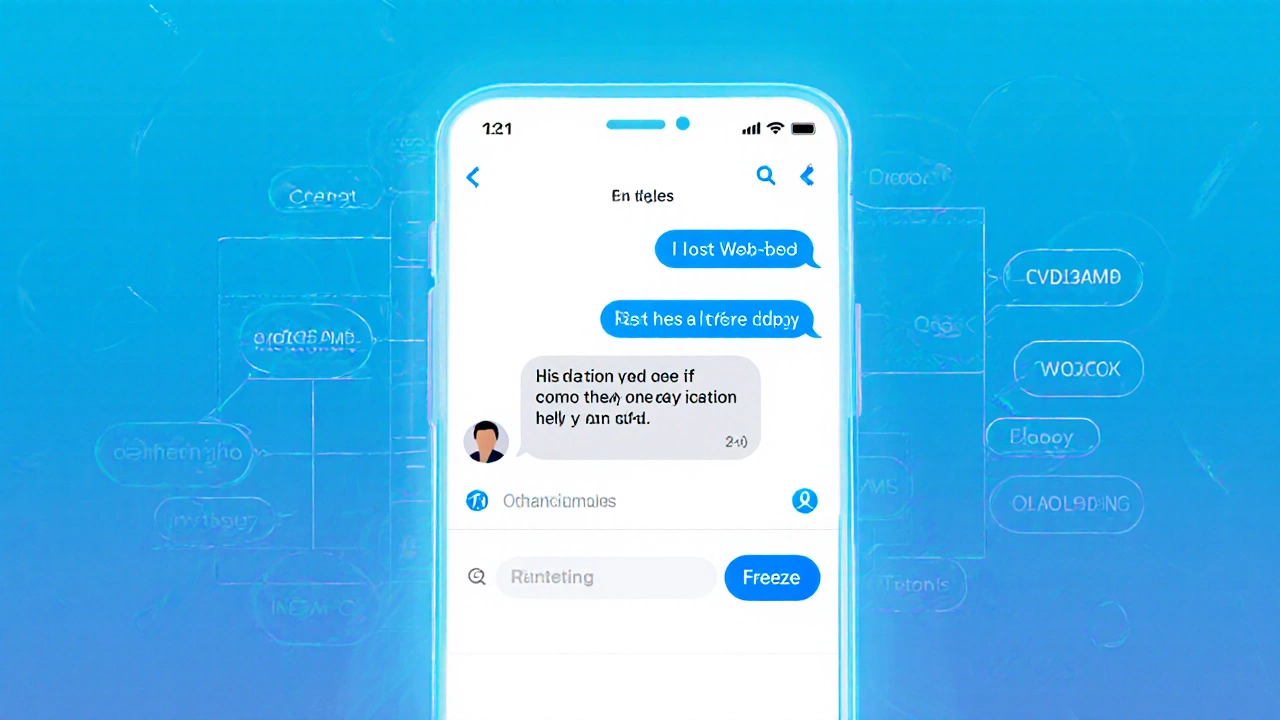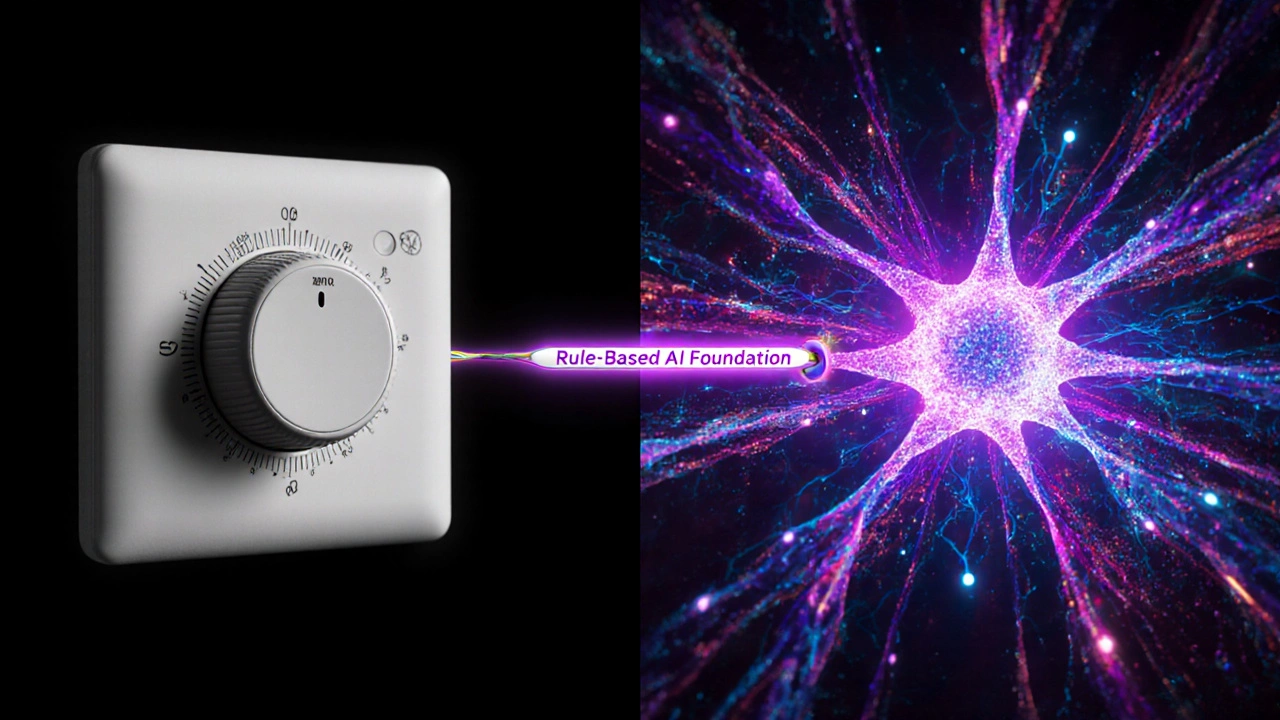When people think of artificial intelligence, they often picture robots that talk like humans or self-driving cars that make split-second decisions. But the simplest form of AI doesn’t need fancy neural networks or massive data sets. It’s been around for decades-and it’s still used today in apps you use every day.
Rule-Based Systems Are the Foundation of AI
The simplest form of AI is a rule-based system. These are programs that follow a fixed set of instructions: if this happens, then do that. No learning. No guessing. Just clear, predictable logic.
Think of a thermostat. When the temperature drops below 68°F, it turns the heat on. When it hits 72°F, it shuts off. That’s not AI to most people-but technically, it is. It’s making a decision based on a rule. Now imagine that same logic applied to customer service: if the user types ‘reset password’, send a reset link. That’s rule-based AI.
These systems were the first real attempt at machine intelligence. In the 1970s, computer scientists built expert systems to mimic how doctors or engineers made decisions. One famous example is MYCIN, developed at Stanford in 1976. It could diagnose bacterial infections and recommend antibiotics with 65% accuracy-comparable to human specialists at the time. It didn’t learn from experience. It just checked symptoms against a database of 600 rules.
How Rule-Based AI Works
Rule-based AI has three parts:
- Knowledge base - a list of facts and rules. For example: ‘If the patient has a fever and a rash, it might be measles.’
- Inference engine - the part that applies the rules to new information. It asks: ‘Does this match any rule?’
- User interface - how people interact with it. Could be a chatbox, a form, or even a voice prompt.
These systems are rigid. They can’t handle surprises. If you ask a rule-based chatbot ‘What’s the meaning of life?’ and no one wrote a rule for that, it either crashes or says ‘I don’t understand.’ But that’s not a flaw-it’s by design. They’re built for consistency, not creativity.
Where You Still See Rule-Based AI Today
Despite the hype around ChatGPT and generative AI, rule-based systems are everywhere:
- Customer service bots - when you type ‘I lost my card’ and get a link to freeze it, that’s rules.
- Email filters - ‘If sender is [email protected], move to junk.’
- Bank fraud detection - ‘If a $5,000 transfer happens at 3 a.m. from a new country, flag it.’
- Video game NPCs - enemies that chase you when you enter their zone, or NPCs that say the same lines every time.
These aren’t ‘dumb’ systems. They’re optimized for speed and reliability. You don’t need a neural net to block spam. You just need a list of known spam words and a rule to delete anything that matches.

Why Rule-Based AI Still Matters
Some people think rule-based AI is outdated. But here’s the truth: most AI systems today still start with rules. Even the most advanced models use rules to clean up their output, filter harmful responses, or enforce safety limits.
Rule-based systems are also cheaper and easier to audit. If a bank’s AI denies a loan, you can trace exactly which rule caused it. With deep learning? Good luck. You can’t explain why a neural net said ‘no’-it’s a black box.
For small businesses, nonprofits, or local governments, rule-based AI is the only practical option. You don’t need millions of dollars or a team of PhDs to build one. You can create a simple chatbot for your clinic’s appointment system using free tools like Dialogflow or Microsoft Power Virtual Agents-no coding required.
When Rule-Based AI Fails
Rule-based systems break when the real world gets messy. Imagine a chatbot for a hospital that says: ‘If the patient says “chest pain”, recommend ER.’ Sounds smart. But what if the patient says: ‘My dog just died and I feel like I’m having a heart attack’? Or: ‘I have chest pain after eating spicy food’?
Without context, understanding, or learning, the system can’t adapt. It doesn’t know the difference between anxiety and a heart attack. That’s why modern AI layers machine learning on top of rules-using the simplicity of rules for known cases, and learning for the gray areas.

Is Rule-Based AI Really AI?
Sometimes people argue: ‘That’s not real AI-it’s just programming.’ But that’s like saying a bicycle isn’t transportation because it doesn’t have an engine. AI doesn’t have to be human-like to be AI. The goal isn’t to copy the brain-it’s to make machines act intelligently.
The Association for the Advancement of Artificial Intelligence defines AI as ‘systems that perceive their environment and take actions to maximize their chance of success.’ Rule-based systems do exactly that. They perceive input (a user’s question), process it (match it to a rule), and act (send a reply).
If you’re learning about AI, start here. Don’t jump into neural networks. Build a simple chatbot that answers FAQs. Watch how it handles edge cases. That’s where you’ll understand the real challenges-and the real power-of AI.
What Comes After Rule-Based AI?
Rule-based systems are the first step. After that, you get:
- Machine learning - systems that learn from data, like spam filters that improve over time.
- Deep learning - neural networks that recognize patterns in images, speech, or text.
- Generative AI - models that create new content, like writing emails or generating images.
But none of these would exist without the foundation of rules. Every AI system today still uses rules for safety, structure, and control. The smartest AI isn’t the one that knows the most-it’s the one that knows when to stick to rules and when to learn.
Is a thermostat considered AI?
Yes, technically. A thermostat follows a simple rule: if temperature is below X, turn on heat. That’s a basic form of rule-based AI. It perceives its environment (temperature), makes a decision, and takes action. It doesn’t learn, but it still meets the core definition of AI: acting intelligently based on input.
Can rule-based AI get smarter over time?
No, not by itself. Rule-based systems don’t learn from experience. If you want them to improve, a human has to update the rules. That’s why they’re often paired with machine learning-rules handle known cases, and learning handles new ones.
Is Siri or Alexa rule-based AI?
Partly. Siri and Alexa use rule-based systems for simple commands like ‘Set a timer for 10 minutes’ or ‘Call Mom.’ But for open-ended questions like ‘Why is the sky blue?’ they switch to deep learning models trained on massive text data. So they’re hybrids-rules for structure, learning for flexibility.
Can I build rule-based AI without coding?
Yes. Tools like Dialogflow, Microsoft Power Virtual Agents, and Chatfuel let you create rule-based chatbots using drag-and-drop interfaces. You write conditions like ‘If user says X, respond with Y.’ No programming needed. Many small businesses use these for customer support.
Why do companies still use rule-based AI if it’s so limited?
Because it’s reliable, fast, and transparent. If a rule denies a loan application, you can explain why. With deep learning, you can’t. Rule-based systems also cost less to run and don’t need constant retraining. For tasks with clear patterns-like filtering spam or routing calls-they’re still the best choice.
If you want to understand AI, don’t start with the most complex version. Start with the simplest. Build a chatbot that answers three questions. Watch how it fails. That’s where the real lessons begin.





